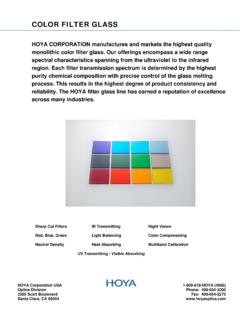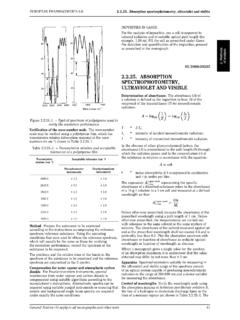Transcription of Chapter 20 Light: Wave Nature 20.1 Electromagnetic ...
1 Electromagnetic SpectrumI01. A radar signal has a frequency of GHz (1 GHz = x 109Hz). What is its wavelength?02. What is the frequency of a microwave whose wavelength is cm?03. What is the wavelength of K-Rock's carrier wave at MHz on the FM dial? (1 MHz = x 106Hz)04. An X-ray has a wavelength of (1D=1x10-10m). What is its frequency?05. What is the wavelength range of the visible portion of the EM spectrum ?06. Find the frequency for each of the following colors of ) red (l= 700 nm)b.) violet (l= 400 nm)c.) yellow (l= 589 nm)d.) green (l= 550 nm)07. What portion of the EM spectrum has wavelengths _____ than visible light?a.) shorterb.) longerRefraction of LightFor problems 08-10, refer toHomework #151for the table of "Indices of Refraction (l= 589 nm)" in" Chapter 19-Light: Geometric Optics".I08. A source of light has a wavelength of 650 nm in air. What is the wavelength of light in crown glass?09. A source of light has a wavelength of 650 nm in air.
2 What is the wavelength of light in water?10. A source of light has a wavelength of 650 nm in air. What is the wavelength of light in diamond?11. The wavelength of light from a sodium lamp is 589 nm when in air. If the light from this lamp is determined tohave a wavelength of 366 nm when traveling through turquoise, what is the index of refraction of turquoise? Chapter 20 Light: Wave Electromagnetic spectrum /Refraction of Light Homework # 161 x ) x 1014 Hzb.) x 1014 Hzc.) x 1014 Hzd.) x ) ultravioletb.) A beam of 475-nm light strikes two closely-spaced slits. A third-order fringe is produced at angle of thedirection of the initial beam. How far apart are the slits?02. Monochromatic light falls on a two slits that are apart. A diffraction and interference pattern is observedwith a fifth-order fringe appearing at an angle of the original path of the light. What is the wavelengthof this light?
3 II03. A beam of 450-nm light strikes two slits that are apart producing a diffraction and interference pattern ona screen m away. How far apart are the fringes on the screen?04. Monochromatic light falls on two slits that are mm apart producing a diffraction and interference pattern ona screen m away with fringes that are cm apart. What is the wavelength of light?05. A parallel beam of 525-nm light passes through a double slit onto a screen that is m away creating fringes thatare cm apart. How far apart are the slits?06. Monochromatic light passes through two slits that are mm apart onto a screen that is m away. For eachof the following wavelengths, determine the distance between fringes produced on the ) 400 nmb.) 500 nmc.) 600 nmd.) 700 nm07. A beam of 550-nm light passes through a double-slit onto a screen that is m away and the distance betweenthe fringes is measured. Once the measurement is made, the first double-slit is replaced by a second with adifferent distance between the slits.
4 This experiment is repeated with a third and fourth trial, each time changingthe double-slit spacing distance. For each of the following double-slit spacings, determine the distance betweenfringes produced on the ) ) ) ) Light with a wavelength of 480 nm strikes two slits that are x 10-2mm apart and illuminate a screen maway with a diffraction and interference pattern. How far from the central fringe will the sixth-order fringe appear?09. Visible white light hits two slits that are apart producing successive rainbow patterns on a screen ) How far from the central fringe will the second order appear for the longest-wavelength red light?b.) How far from the central fringe will the third order appear for the shortest-wavelength violet light?c.) What can be said of the second and third "rainbows" produced?10. Light with a wavelength of 650 nm strikes two slits that are x 10-5m apart and produce a diffraction andinterference pattern on a screen m away.
5 How wide will the central fringe be that appears on the screen? Chapter 20 Light: Wave and Interference-Double Slit PhenomenonHomework # 162 ) cmb.) cmc.) cmd.) ) cmb.) cmc.) ) ) cmb.) cmc.) overlap of 2nd & 3rd cmI01. What is the angular width of the central diffraction peak when 490-nm light falls on a slit 40mm wide?02. Monochromatic light passes through a slit with a width of x 10-3mm creating a diffraction and interferencepattern where the angle between the dark fringes on either side of the central maximum is What is thewavelength of light used?03. Monochromatic light with a wavelength of 630 nm passes through a slit creating a central angular width of is the width of this slit?II04. How wide is a central diffraction peak on a screen m behind a slit, with a width of mm, whenilluminated by 440-nm light?05. If 530-nm light diffracts through a single slit producing a central-fringe width of cm on a screen maway, what must be the width of the slit?
6 06. Monochromatic light passes through a single slit with a width of 38mm creating a central fringe that is cmwide on a screen m away. What is the wavelength of light used? Chapter 20 Light: Wave and Interference-Single Slit PhenomenonHomework # 163 nmI01. Light with a wavelength of 460 nm strikes a diffraction grating with slits that are mm apart. At what anglefrom the center of the interference pattern will the third-order maximum occur?02. A beam of light with wavelength of 580 nm falls on a diffraction grating producing a second-order line at ) How far apart are the slits?b.) How many lines per centimeter does the grating have?II03. Light with a wavelength of 680 nm falls on a diffraction grating producing a third-order maximum at an angle How many lines per centimeter does the grating have?04. Monochromatic light passes through a grating with 1200 lines/cm and produces a second-order maximum at anangle of What is the wavelength of light used?
7 05. Light with a wavelength of 420 nm passes through a grating with 5500 lines/cm. At what angle from the centralpeak will the fourth-order maximum occur?06. An experiment is done using light with a wavelength of 500 nm. The procedure calls for the student to measurethe angle of the first-order maximum for four different diffraction gratings. Predict the results of this experimentif the four gratings used have the following ) 1000 lines/cmb.) 2000 lines/cmc.) 4000 lines/cmd.) 8000 lines/cm07. A grating has 4000 lines/cm. How manyFULL spectral orders can be seen when illuminated by white light? Chapter 20 Light: Wave and Interference-Multiple Slit PhenomenonHomework # 164 ) ) 4000 ) ) ) ) [3 full spectra on either side of the central fringe. Therewill be 6 violet fringes, but only 3 red. None of the spectra on either side of the central fringe will appear withoutsome overlap of the next higher order spectrum .]
8 : The longest red wavelength (l= 700 nm) for the first orderspectrum (m = 1, or 1 wavelengths of red) will appear at angle of the center, while the shortest violetwavelength (l= 400 nm) for the second order spectrum (m = 2, or 2 wavelengths of violet) will appear at the center.]Refer to the table of "Indices of Refraction (l= 589 nm)" found onHomework #151in " Chapter 19- Light: Geometric Optics".I01. A soap bubble, withn. 134,is nm thick. When white light strikes the surface normally, what color(wavelength) will appear at the center? Assume the thickness of the soap bubble is the minimum thickness to seethis color (wavelength).02. Monochromatic light with a wavelength of 540 nm encounters a hollow glass ball (n= ) filled with air. If thelight hits the surface of the glass normally and is visible to the eye at the surface, what is the minimum thickness ofthe glass?II03. Two long, flat pieces of glass plates are placed one on top of the other separated only by a thin piece of plastic atone end (See diagram below).
9 If there are 37 dark and 37 bright lines from one end of the pair of glass plates to theother (where the thin piece of plastic is located) when illuminated by a sodium lamp (l= 589 nm), how thick is thepiece of plastic?04. What is the minimum thickness of air between two flat glass plates if light with a wavelength of 580 nm is toappear _____ when it is incident normally?a.) brightb.) dark05. If thickness of the air trapped between two flat glass plates is , and a monochromatic light is visible at itssurface when incident normally, what is the wavelength of light?06. A layer of motor oil (n= ) is spread over a puddle of water on the blacktop. If orange (l= 625 nm) light isvisible when normally incident, what is the minimum thickness of the layer of oil?III07. A thin film of ethyl alcohol is spread over a flat piece of light flint glass. Monochromatic light, whose wavelengthcan be varied, is slowly increased from 400-700 nm and is directed normally to the surface of the alcohol.
10 Thereflected light is a minimum (darkest) forl= 512 nm and a maximum (brightest)l= 640 nm, what is thethickness of the film? Chapter 20 Light: Wave Thin FilmsHomework # 165 ) 145 nmb.) 290 nmThin piece of plasticGlass PlatesProblem 03 Refer to the table of "Indices of Refraction (l= 589 nm)" found onHomework #151in " Chapter 19- Light: Geometric Optics".I01. Two polarizers have polarizing axes at a to one another. What fraction of unpolarized lightdirected at this pair of polarizers will be transmitted through the pair?02. Light passes through a polarizer blocking half of the light. What fraction of thisREMAINING light will passthrough a second polarizer at an angle of the first?03. What is Brewster's angle for a flat piece of glass crown glass sitting in a room filled with air?04. What is Brewster's angle for a flat piece of glass crown glass submerged in water?II05. At what angle should the polarizing axes of two polarizers be oriented so that one-eighth of the originalintensity of light passes through?











